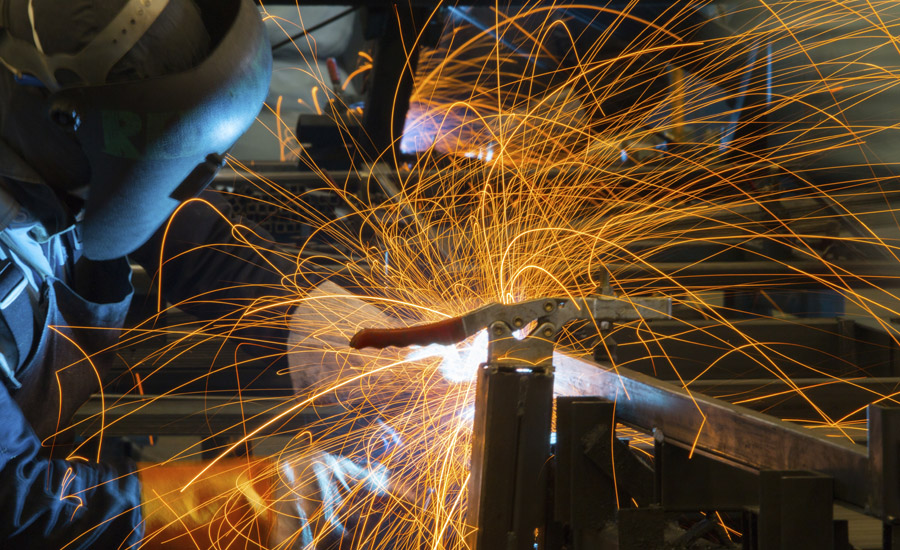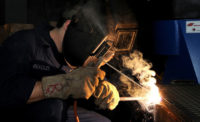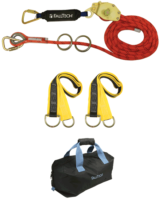Like other jobs or careers, welders must wear suitable protective equipment. In general, Personal Protective Equipment (PPE) must protect against hazards such as burns, sparks, spatter, electric shock, and radiation. The use of PPE is a good safe practice and may be required by regulatory agencies. For example, OSHA requires the use of PPE when engineering and administrative controls are not feasible or effective.
Nature of the hazard
Welding and cutting can produce hazards such as sparks, spatter, radiation (infrared, ultraviolet, and blue light), slag, heat, hot metal, fumes and gases, and even electric shock. Since these hazards may causeburns, injury, or death, it is important to wear proper PPE at all times.
• Wear a helmet with filter lens and cover plate that complies with ANSI Z87.1 for protection from radiant energy, flying sparks, and spatter.
• According to ANSI Z49.1 and OSHA 29CFR 1910.252, "Helmets and hand shields shall protect the face, forehead, neck, and ears to a vertical line in back of the ears, from the direct radiant energy from the arc and from direct weld spatter."
• Helmets shall be made of material that complies with ANSI Z49.1.
• Filter lenses and cover plates must meet the tests prescribed in ANSIZ87.1.
• Wear approved safety glasses with side shields (or goggles) under your helmet.
• The safety glasses with side shields (or goggles) are used to protect against flying metal, slag chips, grinding fragments, wire wheel bristles, and similar hazards, which can ricochet under the helmet.
• Choose a filter lens shade according to the Lens Shade Selector Chart in ANSIZ49.1 or AWS F2.2. Lens Shade Selector.
• Consult AWS Fact Sheet 31, Eye and Face Protection for Welding and Cutting Operations.
• Wear a fire-resistant welder’s cap or other head covering under your helmet. It will protect your head and hair from flying sparks, spatter, burns, and radiation.
• When working out of position, such as overhead, wear approved ear-plugs or muffs. They prevent sparks, spatter, and hot metal from entering your ears and causing burns.
• If loud noise is present, wear approved earplugs or muffs to protect your hearing and prevent hearing loss.
• Select boots that meet the requirements of ASTM F2412 and ASTM F2413 (or the older ANSI Z41which has been withdrawn). Look for a compliance mark inside your boot.
• Wear leather, steel-toed, high-topped boots in good condition. They will help protect your feet and ankles from injury.
• In heavy spark or slag areas, use fire resistant boot protectors or leather spats strapped around your pant legs and boot tops to prevent injury and burns.
• Do not wear pants with cuffs. Wear the bottoms of your pants over the tops of your boots to keep out sparks and flying metal. Do not tuck pant legs into your boots.
Hand protection
• Always wear dry, hole-free, insulated welding gloves in good condition. They will help protect your hands from burns, sparks, heat, cuts, scratches, and electric shock.
• ANSI Z49.1 requires all welders to wear protective flame-resistant gloves, such as leather welder's gloves. They should provide the heat resistance and general hand protection needed for welding.
Body protection
• Wear oil-free protective clothing made of wool or heavy cotton. Heavier materials work best. They are harder to ignite and resist wear and damage.
• Choose clothing that allows freedom of movement and covers all areas of exposed skin. Wear long sleeved shirts(no t-shirts), and button the cuffs, pockets, and collar. They will protect your arms and neck from radiation exposure and skin burns (caused by ultraviolet radiation from the arc).
• Wear heavy, durable, long pants (no shorts) without cuffs that overlap the tops of your boots.
• Keep clothing dry. Change it when needed (this reduces the possibility of electric shock).
• Be aware that any cuffs or open pockets can catch flying sparks and start on fire easily. Unroll cuffs and button pockets to prevent spark entry.
• Keep clothing clean (free of oil, grease, or solvents which may catch fire and burn easily). Keep it in good repair (no holes, tears, or frayed edges). Always follow the manufacturer's directions for their use, care, and maintenance.
Remove all flammables and matches and cigarette lighters from your pockets.
• Do not wear synthetic (man-made) fabrics because they may burn easily, melt, stick to your skin, and cause serious burns.
• Wear leather aprons, leggings, capes and sleeves as needed for the application. Leather protects better than most materials. Read ANSI Z49.1. It gives a full explanation of the protective clothing needed when welding or cutting. In brief,Z49.1 states that “Clothing shall provide sufficient coverage, and be made of suitable materials, to minimize skin burns caused by sparks, spatter, or radiation.” Full details are in the document.
Respiratory protective equipment
For information on respirators, see ANSIZ49.1 and Fact Sheet 37. Also see OSHA and NIOSH regulations.
Source: American Welding Society



